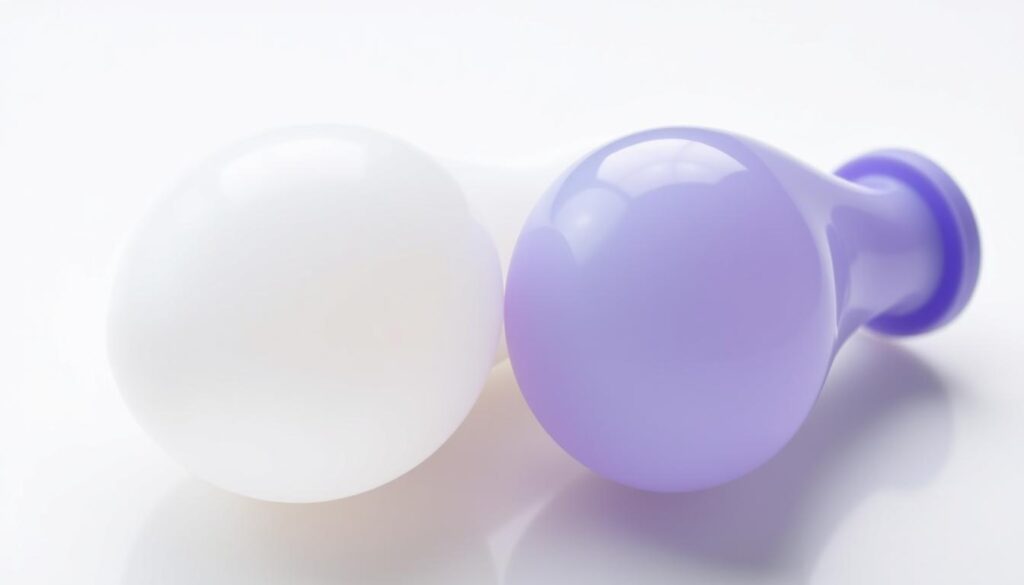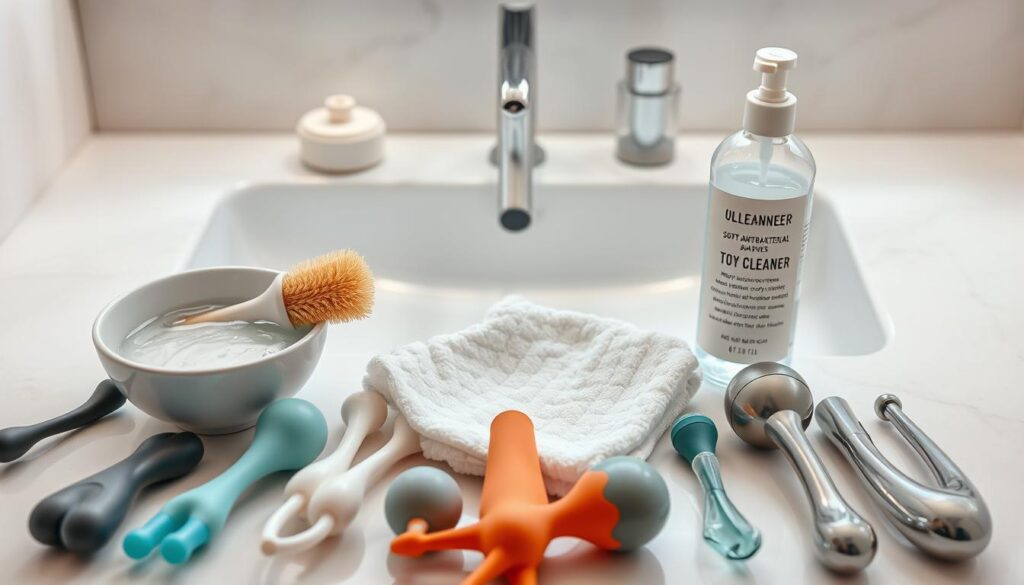Choosing the right material for personal pleasure products has always mattered. Centuries ago, people used wood, stone, or even animal bones to craft intimate items. Today, advancements in design prioritize body-safe materials that balance safety, comfort, and performance.
Modern options like silicone and ABS plastic dominate the market. Silicone stands out for its soft texture and hypoallergenic qualities, making it ideal for sensitive skin. It’s also non-porous, which simplifies cleaning and reduces bacterial buildup. On the other hand, ABS plastic offers a sleek, rigid feel that efficiently transfers vibrations for intense sensations.
Safety remains a top priority. Manufacturers now avoid harmful chemicals like phthalates, focusing instead on non-toxic, durable formulas. This shift reflects growing consumer demand for products that last longer while prioritizing health.
Understanding these materials helps users make informed choices. Whether someone values flexibility, power, or ease of maintenance, today’s options cater to diverse preferences. Let’s explore how these innovations shape the future of intimate wellness.
Key Takeaways
- Body-safe materials like silicone and ABS plastic prioritize user health and durability.
- Silicone is hypoallergenic, non-porous, and easy to clean for sensitive skin.
- ABS plastic enhances vibration intensity and offers a smooth, glossy finish.
- Modern manufacturing avoids harmful chemicals, focusing on non-toxic alternatives.
- Material choice depends on personal preferences for texture, power, and maintenance.
Introduction to Sex Toy Materials and Safety
From ancient artifacts to modern innovations, material choices in intimate items reflect changing priorities. Early cultures used leather, carved stone, or beeswax for pleasure objects. Today’s designs emphasize body-safe engineering, blending comfort with advanced hygiene standards.
The Evolution of Intimate Product Composition
Historical records show Egyptians used polished stone, while Renaissance-era Europeans experimented with rubber. These early materials often lacked durability or safety. Modern manufacturing shifted focus to non-toxic compounds after studies revealed health risks in porous alternatives.
Surface Types and Hygiene Impact
Porous surfaces have microscopic holes that trap moisture and bacteria. Non-porous options create smooth barriers against contaminants. This difference determines cleaning methods and product lifespan.
| Material Type | Surface Structure | Cleaning Difficulty | Bacterial Risk |
|---|---|---|---|
| Porous (Rubber, Latex) | Sponge-like | High | Elevated |
| Non-Porous (Silicone, ABS) | Sealed | Low | Minimal |
Consumers now prioritize easy-to-clean options that withstand boiling or alcohol wipes. Textured surfaces require extra attention, while glossy finishes simplify maintenance. These factors help users balance feel and practicality when selecting products.
Industry leaders continue refining material blends to enhance vibration patterns and tactile experiences. This progress meets growing demands for items that perform well while supporting long-term safety goals.
Silicone vs. ABS Plastic Vibrators: Material Properties and Benefits
Modern intimacy products balance innovation with safety, offering materials tailored to diverse needs. Two leading options dominate today’s market, each bringing unique strengths to personal wellness experiences.

Flexible and Body-Friendly Options
Premium-grade flexible materials excel in comfort and safety. Their non-porous surfaces resist bacterial growth while retaining warmth for natural-feeling interactions. Medical certifications confirm their hypoallergenic nature, ideal for sensitive users.
These options adapt to body contours, creating personalized sensations. Popular designs like the SVAKOM Erica showcase how soft textures enhance intimate moments without compromising durability. Cleaning becomes simple with soapy water or specialized sprays.
Rigid Structures for Powerful Performance
Dense, polished alternatives provide unmatched vibration transfer due to their solid composition. Their smooth surfaces allow effortless cleaning – a quick wipe preserves hygiene between uses. This makes them perfect for those prioritizing intense stimulation.
Bullet-style designs demonstrate how hard plastic maintains structural integrity through years of use. Unlike porous alternatives, these materials won’t degrade when exposed to quality lubricants. Their glossy finishes also resist scratches better than some metal alloys.
While body-safe materials like stainless steel offer different benefits, most users find either flexible or rigid options better suit their tactile preferences. The choice ultimately depends on whether someone values plush comfort or precise power delivery.
Safety Considerations and Proper Cleaning Techniques
Maintaining intimate products requires attention to hygiene and material safety. Proper care prevents bacterial growth while preserving device quality. Let’s explore methods that keep items fresh and functional for years.

Best Practices for Cleaning and Disinfection
Non-porous options like premium-grade polymers allow easy clean routines. Wash them with mild, unscented soap and warm water after every use. For deeper sanitization, some materials tolerate boiling – check manufacturer guidelines first.
Porous items demand extra caution. Their textured surfaces may contain hidden crevices where germs thrive. A gentle antibacterial spray or specialized wipes work best here. Always dry thoroughly with lint-free cloths to prevent moisture buildup.
Using Barriers and Condoms for Shared Toys
Condoms or dental dams create protective layers on products that contain phthalates or questionable compounds. This barrier method proves especially useful for rubber-based items, which often may contain irritants. Replace covers between partners to avoid cross-contamination.
Rubber toys also need careful handling during cleaning. Harsh scrubbing can damage their surface, creating entry points for bacteria. Stick to soft sponges and lukewarm water to maintain integrity while ensuring hygiene.
Regular maintenance extends product lifespan and safeguards health. Store cleaned items in breathable pouches away from direct heat. Following these steps helps users enjoy their purchases safely for countless adventures.
Durability, Performance, and Realistic Feel in Material Comparisons
Material selection shapes how intimate products hold up over time and perform during use. Flexible polymers often mimic natural textures, while rigid options prioritize structural integrity. Let’s explore how different compositions balance lasting power with sensory appeal.
Comparing Material Strength and Longevity
Flexible, non-porous polymers maintain their shape through years of regular use. Their bendable nature resists cracks from accidental drops. These options often work well for dildos needing a lifelike feel. However, extreme heat can warp their surface if left near radiators or in hot cars.
Rigid thermoplastics excel in vibration transfer but may chip if mishandled. Glass and stainless steel offer unmatched durability when cared for properly. A 2022 industry report found these metal options last 3-5 years longer than many plastics when cleaned with pH-neutral solutions.
Repeated cleaning impacts lifespan too. Non-porous surface types handle frequent washing without degrading. Avoid products containing phthalates, as these chemicals weaken materials over time. Always check temperature limits – boiling water sanitizes glass but damages some polymers.
Texture preferences also guide choices. Smooth, glossy finishes feel sleek but lack grip when wet. Matte textures provide better control during use. Whether someone prioritizes a velvet-soft surface or unyielding firmness, today’s materials deliver tailored experiences without compromising safety.
Choosing the Right Material for Your Sexual Wellness
Personal preferences and health factors play pivotal roles in selecting intimate wellness products. While some prioritize velvety textures, others seek materials that resist bacterial growth. Understanding this balance transforms how people approach their pleasure journey.
Matching Material to Sensory and Health Needs
Start by identifying your tactile priorities. Flexible options mimic natural contours, while rigid designs deliver precise stimulation. Non-porous surfaces excel at preventing bacteria buildup – a critical factor for frequent users.
Hypoallergenic choices like medical-grade polymers reduce irritation risks. As one wellness expert notes:
“The best choice marries safety with what feels authentically satisfying.”
Always verify certifications for phthalate-free formulas when comparingproducts.
Considerations for Allergies and Chemical Safety
Those with sensitivities should avoid porous surfaces that trap irritants. Instead, opt for seamless designs without seams or textures that could harbor allergens. For shared items, condom use adds protection against cross-contamination.
Practical tips for smart selection:
- Review cleaning requirements – non-porous materials handle boiling water better
- Check manufacturer transparency about chemical compositions
- Test small areas first if prone to skin reactions
This body-safe guide helps navigate technical specifications from trusted brands. Remember: your health and pleasure deserve materials that support both.
Conclusion
Selecting intimate wellness tools involves more than personal preference—it’s about balancing safety, performance, and maintenance. Flexible options prioritize gentle texture and hypoallergenic properties, while rigid counterparts excel in delivering consistent power. Both require proper cleaning routines and occasional barrier protection to maintain hygiene.
Glass sex toys and polished alternatives offer unique benefits like temperature play and scratch resistance. Their non-porous surfaces simplify care compared to some plastic sex toys, though all quality items demand attention to cleaning guidelines. Always verify certifications when choosing your sex toy material.
Prioritizing pleasure means considering how a product’s finish interacts with your body. Smooth surfaces glide effortlessly, while matte textures provide grip. Whether exploring glass sex toys or sleek plastic abs plastic designs, the right choice harmonizes tactile satisfaction with practical upkeep.
Ultimately, informed decisions lead to lasting enjoyment. By weighing factors like texture, durability, and care requirements, users enhance both their experiences and product lifespans. Every sex toy material—from shimmering glass sex toys to lightweight plastic sex toys—offers pathways to deeper pleasure when chosen thoughtfully.

